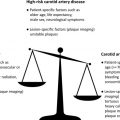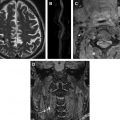At present, patients with carotid disease are selected for invasive recanalization therapies mainly based on the degree of luminal narrowing and the presence or absence of recent ischemic symptoms. A more sophisticated risk model takes into account other clinical variables, such as age, sex, and the type of recent symptoms, as well as presence of ulcerated plaque. A growing body of evidence shows that noninvasive imaging of the carotid plaque by various methods reliably identifies structural correlates of plaque vulnerability, which are associated with an increased risk of cerebrovascular events.
Integration of plaque imaging at baseline in randomized controlled trials is needed to test the hypothesis that plaque imaging helps select patients who benefit from carotid revascularization. If this holds true, then plaque imaging should be incorporated in management guidelines.
Integration of plaque imaging at baseline in randomized controlled trials is needed to test the hypothesis that plaque imaging helps select patients who benefit from carotid revascularization. If this holds true, then plaque imaging should be incorporated in management guidelines.
A meta-regression analysis of data from medical arms of randomized trials and prospective cohorts suggested that the risk of ipsilateral stroke associated with asymptomatic carotid stenosis has declined over the past 20 years and may now be only 1% per year or lower, most likely attributable to advances in medical therapy. Indeed, under modern medical management of atherosclerosis, only a minority of patients with asymptomatic carotid disease may currently benefit from invasive revascularization.
References
- 1. Global, regional, and national age-sex specific all-cause and cause-specific mortality for 240 causes of death, 1990-2013: a systematic analysis for the global burden of disease study 2013. Lancet 2015; 385: pp. 117-171
- 2. Lovett J.K., Coull A.J., and Rothwell P.M.: Early risk of recurrence by subtype of ischemic stroke in population-based incidence studies. Neurology 2004; 62: pp. 569-573
- 3. Schneider A.T., Kissela B., Woo D., et al: Ischemic stroke subtypes: a population-based study of incidence rates among blacks and whites. Stroke 2004; 35: pp. 1552-1556
- 4. de Weerd M., Greving J.P., Hedblad B., et al: Prevalence of asymptomatic carotid artery stenosis in the general population: an individual participant data meta-analysis. Stroke 2010; 41: pp. 1294-1297
- 5. Barnett H.J., Taylor D.W., Eliasziw M., et al: Benefit of carotid endarterectomy in patients with symptomatic moderate or severe stenosis. North American Symptomatic Carotid Endarterectomy Trial collaborators. N Engl J Med 1998; 339: pp. 1415-1425
- 6. Randomised trial of endarterectomy for recently symptomatic carotid stenosis: final results of the MRC European Carotid Surgery Trial (ECST). Lancet 1998; 351: pp. 1379-1387
- 7. Mayberg M.R., Wilson S.E., Yatsu F., et al: Carotid endarterectomy and prevention of cerebral ischemia in symptomatic carotid stenosis. Veterans Affairs cooperative studies program 309 trialist group. JAMA 1991; 266: pp. 3289-3294
- 8. Rothwell P.M., Eliasziw M., Gutnikov S.A., et al: Analysis of pooled data from the randomised controlled trials of endarterectomy for symptomatic carotid stenosis. Lancet 2003; 361: pp. 107-116
- 9. Purroy F., Montaner J., Molina C.A., et al: Patterns and predictors of early risk of recurrence after transient ischemic attack with respect to etiologic subtypes. Stroke 2007; 38: pp. 3225-3229
- 10. Eckstein H.H., Ringleb P., Allenberg J.R., et al: Results of the stent-protected angioplasty versus carotid endarterectomy (space) study to treat symptomatic stenoses at 2 years: a multinational, prospective, randomised trial. Lancet Neurol 2008; 7: pp. 893-902
- 11. Mas J.L., Arquizan C., Calvet D., et al: Long-term follow-up study of endarterectomy versus angioplasty in patients with symptomatic severe carotid stenosis trial. Stroke 2014; 45: pp. 2750-2756
- 12. Bonati L.H., Dobson J., Featherstone R.L., et al: Long-term outcomes after stenting versus endarterectomy for treatment of symptomatic carotid stenosis: the International Carotid Stenting Study (ICSS) randomised trial. Lancet 2015; 385: pp. 529-538
- 13. Lal B.K., Beach K.W., Roubin G.S., et al: Restenosis after carotid artery stenting and endarterectomy: a secondary analysis of crest, a randomised controlled trial. Lancet Neurol 2012; 11: pp. 755-763
- 14. Bonati L.H., Lyrer P., Ederle J., et al: Percutaneous transluminal balloon angioplasty and stenting for carotid artery stenosis. Cochrane Database Syst Rev 2012; undefined:
- 15. Bonati L.H., Dobson J., Algra A., et al: Short-term outcome after stenting versus endarterectomy for symptomatic carotid stenosis: a preplanned meta-analysis of individual patient data. Lancet 2010; 376: pp. 1062-1073
- 16. Endarterectomy for asymptomatic carotid artery stenosis. Executive committee for the asymptomatic carotid atherosclerosis study. JAMA 1995; 273: pp. 1421-1428
- 17. Halliday A., Mansfield A., Marro J., et al: Prevention of disabling and fatal strokes by successful carotid endarterectomy in patients without recent neurological symptoms: randomised controlled trial. Lancet 2004; 363: pp. 1491-1502
- 18. Abbott A.L.: Medical (nonsurgical) intervention alone is now best for prevention of stroke associated with asymptomatic severe carotid stenosis: results of a systematic review and analysis. Stroke 2009; 40: pp. e573-e583
- 19. European Stroke O., Tendera M., Aboyans V., et al: ESC guidelines on the diagnosis and treatment of peripheral artery diseases: document covering atherosclerotic disease of extracranial carotid and vertebral, mesenteric, renal, upper and lower extremity arteries: the Task Force on the Diagnosis and Treatment of Peripheral Artery Diseases of the European Society of Cardiology (ESC). Eur Heart J 2011; 32: pp. 2851-2906
- 20. Brott T.G., Halperin J.L., Abbara S., et al: 2011 ASA/ACCF/AHA/AANN/AANS/ACR/ASNR/CNS/SAIP/SCAI/SIR/SNIS/SVM/SVS guideline on the management of patients with extracranial carotid and vertebral artery disease. Stroke 2011; 42: pp. e464-540
- 21. Eckstein H.H., Kuhnl A., Dorfler A., et al: The diagnosis, treatment and follow-up of extracranial carotid stenosis. Dtsch Arztebl Int 2013; 110: pp. 468-476
- 22. Brown MM, Bonati LH, Söderman M, et al. Karolinksa stroke update consensus statement 2012: carotid endarterectomy vs. angioplasty and stenting. 2012. Available at: http://www.strokeupdate.org/Cons_Carotid_session_2012.aspx.
- 23. Kernan W.N., Ovbiagele B., Black H.R., et al: Guidelines for the prevention of stroke in patients with stroke and transient ischemic attack: a guideline for healthcare professionals from the American Heart Association/American Stroke Association. Stroke 2014; 45: pp. 2160-2236
- 24. Rothwell P.M., and Warlow C.P.: Prediction of benefit from carotid endarterectomy in individual patients: a risk-modelling study. European Carotid Surgery Trialists’ Collaborative Group. Lancet 1999; 353: pp. 2105-2110
- 25. Rothwell P.M., Mehta Z., Howard S.C., et al: Treating individuals 3: from subgroups to individuals: general principles and the example of carotid endarterectomy. Lancet 2005; 365: pp. 256-265
- 26. Brice J.G., Dowsett D.J., and Lowe R.D.: Haemodynamic effects of carotid artery stenosis. Br Med J 1964; 2: pp. 1363-1366
- 27. Halliday A., Harrison M., Hayter E., et al: 10-year stroke prevention after successful carotid endarterectomy for asymptomatic stenosis (ACST-1): a multicentre randomised trial. Lancet 2010; 376: pp. 1074-1084
- 28. Ross R.: Atherosclerosis–an inflammatory disease. N Engl J Med 1999; 340: pp. 115-126
- 29. Glass C.K., and Witztum J.L.: Atherosclerosis. The road ahead. Cell 2001; 104: pp. 503-516
- 30. Libby P., Ridker P.M., and Maseri A.: Inflammation and atherosclerosis. Circulation 2002; 105: pp. 1135-1143
- 31. Williams K.J., and Tabas I.: The response-to-retention hypothesis of early atherogenesis. Arterioscler Thromb Vasc Biol 1995; 15: pp. 551-561
- 32. Binder C.J., Chang M.K., Shaw P.X., et al: Innate and acquired immunity in atherogenesis. Nat Med 2002; 8: pp. 1218-1226
- 33. Mestas J., and Ley K.: Monocyte-endothelial cell interactions in the development of atherosclerosis. Trends Cardiovasc Med 2008; 18: pp. 228-232
- 34. Johnson J.L., and Newby A.C.: Macrophage heterogeneity in atherosclerotic plaques. Curr Opin Lipidol 2009; 20: pp. 370-378
- 35. Shibata N., and Glass C.K.: Regulation of macrophage function in inflammation and atherosclerosis. J Lipid Res 2009; 50: pp. S277-S281
- 36. Dollery C.M., and Libby P.: Atherosclerosis and proteinase activation. Cardiovasc Res 2006; 69: pp. 625-635
- 37. Hosseini A.A., Kandiyil N., Macsweeney S.T., et al: Carotid plaque hemorrhage on magnetic resonance imaging strongly predicts recurrent ischemia and stroke. Ann Neurol 2013; 73: pp. 774-784
- 38. Saam T., Hetterich H., Hoffmann V., et al: Meta-analysis and systematic review of the predictive value of carotid plaque hemorrhage on cerebrovascular events by magnetic resonance imaging. J Am Coll Cardiol 2013; 62: pp. 1081-1091
- 39. Burow A., Lyrer P.A., Nederkoorn P.J., et al: Echographic risk index and cerebral ischemic brain lesions in patients randomized to stenting versus endarterectomy for symptomatic carotid artery stenosis. Ultraschall Med 2014; 35: pp. 267-272
- 40. Akutsu N., Hosoda K., Fujita A., et al: A preliminary prediction model with MR plaque imaging to estimate risk for new ischemic brain lesions on diffusion-weighted imaging after endarterectomy or stenting in patients with carotid stenosis. AJNR Am J Neuroradiol 2012; 33: pp. 1557-1564
- 41. Yamada K., Yoshimura S., Kawasaki M., et al: Embolic complications after carotid artery stenting or carotid endarterectomy are associated with tissue characteristics of carotid plaques evaluated by magnetic resonance imaging. Atherosclerosis 2011; 215: pp. 399-404
- 42. Uchiyama N., Misaki K., Mohri M., et al: Association between carotid plaque composition assessed by multidetector computed tomography and cerebral embolism after carotid stenting. Neuroradiology 2012; 54: pp. 487-493
Stay updated, free articles. Join our Telegram channel

Full access? Get Clinical Tree





